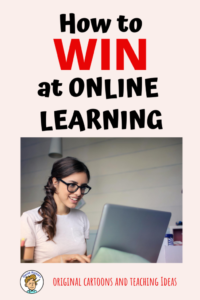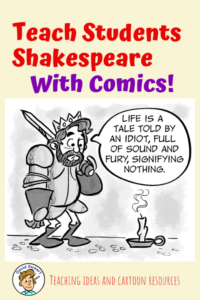
What are sketchnotes?
Sketchnotes are becoming an increasingly popular way for students to take notes for lectures. However, there is much value to be gained from using them along with – or instead of – traditional methods like Cornell notes and annotation. Studies have shown that engaging the visual part of the brain as well as the textual part adds in retention of information. Plus, it’s fun.
Here’s a personal story about the power of sketchnotes. When I was getting ready to do Sketchnotes with my freshmen, I decided to give it a try myself to serve as a model and discover any problems they might face. I did sketchnotes for the first five chapters of Frankenstein before I asked them to do any on their own. I didn’t do any more of the book, But guess what? Those five chapters are the ones I remember the best. Imagine the value of using this tool to really get students to engage with a novel or play.
Here’s a short introductory video I show the students to give them the general idea:
[youtube https://www.youtube.com/watch?v=gY9KdRfNN9w&w=560&h=315]


For our second venture with sketchnotes, I had my freshmen in groups of five, each doing an act of Romeo and Juliet while working as a team to make something that looked like it all belonged together. They were not as successful this time, and I learned that I can’t just show them a few models of sketchnotes and expect them to be able to get the idea. They need more structure. So I developed the visual above to help them organize their ideas before they start.
Here’s the first five things students should do before they put anything down on paper:
Pick a Pattern.
The first thing students need to do is choose an organizational pattern for their sketchnote. If they don’t, they’ll just draw a bunch of things randomly on their paper. They need to think about the ideas that they are presenting and what pattern best suits that. I always have students justify their organization pattern to me and why it works best for what they want to do.
I’m not a big fan for linear patterns because what students tend to do is create a comic or an illustrated version of the text, which isn’t what sketchnotes is all about. I steer students toward either the web or the columns by asking them to sketchnote how a particular main idea or theme is present in the text. Then they might use the web, put the theme in the middle, and show several instances of how that theme was explored around the periphery. Or perhaps they use the columns by placing the theme at the top, choosing two or more characters from the text, and using the columns to fill in how those characters dealt with that theme through conflict. Of course you can use any organization method and do something cool with it, and if they want to do something more sequential I don’t mind as long as they aren’t just retelling the story.
It also bears mentioning that the visuals provided are just guidelines. You don’t need to do a web as a bunch of circles or use rectangles for columns or have a specific number of ideas to work from that you can’t exceed. These are not set in stone.
Choose some frames
Next to the pattern of the sketchnote, frames are the most important organizational feature. They keep text organized and are used to create banners for important ideas. Some lend themselves to specific uses – for instance, a speech bubble could be used for important quotes. But, really any of them will do.
Frames – which serve as containers and keep ideas separate while providing structure – keep the sketchnote from being too messy.
You can find several other examples of interesting frames with a quick online search, especially some that might be particularly well-suited for the novel or play you’re reading in class. I also encourage students to think of frames that might come naturally from the novel – a handkerchief for Othello, for instance.
Select Connectors and Separators
Connectors guide the viewer through the sketchnote and can indicate relationships, such as cause and effect and the passage of time. Simple arrows will do the trick, and most of the choices will be aesthetic because connectors are functional and aren’t responsible for communicating meaning. However, they do provide a place for students to do something fun and artistic.
While connectors link ideas, separators keep everything tidy. They don’t need to be fancy to do the trick. All they need to do is keep related ideas separated from other ideas. Generally I find that students will add these last to add clarity.
Pick some bullets
Sketchnotes need text. A sketchnote with only visuals is just a bunch of pictures. The text is where the true meaning is. And bullets organize text.
Paragraphs will overwhelm the pictures. And students need to remember these are notes, not a paper. That’s where the bullets come in. Just like in a PowerPoint presentation, bullets effectively present main ideas efficiently.
While it’s not that important to linger over which bullets you choose, I like to include this step to emphasize that text is required and paragraphs should be avoided.
Decide on fonts
While fonts are fun, they serve a purpose. Students can choose one font for headings, another font for important information, and another one for quotes. Three seems to be a good number to shoot for – anything else can become difficult for someone looking at it to process.
Fonts are also a good way to introduce hierarchy by making more important words or phrases larger than others. When writing a paper we can underline, italicize, and boldface certain words for emphasis. While you can certainly do those things with handwritten fonts as well, sketchnotes also allows for the opportunity to add emphasis through size.


Not everyone likes sketchnotes. The less artistically inclined would rather take traditional notes (I maintain that the just need more experiences before they are won over.) However, most students found them an effective, absorbing way to process text. Plus, they were great to review for their final paper.
If you’d like the sketchnotes visual featured above as a free download, click here.


I know you’re the kind of teacher that makes their classroom a fun, engaging learning environment. I have a series of lessons done as comics that address various ELA topics like grammar, poetry, editing, and Shakespeare, all of which will make your students glad they came to class that day. All the fun is there for you, and your kids will love studying any of these topics because they’ll get a new comic every day! Please check out my resources and let the learning begin!




